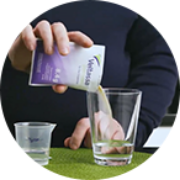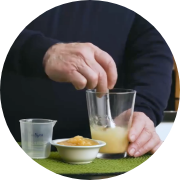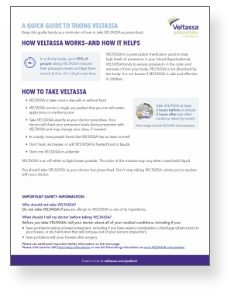How to prepare VELTASSA
It's important to take VELTASSA every day, with or without food, as prescribed by your doctor. If you stop taking VELTASSA, even for a few days, your potassium levels can increase. Here's how to properly prepare VELTASSA.

Mix
- Measure the recommended minimum amount (1/3 cup or about 3 ounces*) of water, other beverages, or soft foods† such as applesauce, yogurt, or pudding in a measuring cup
- Pour half of the water, other beverages, or soft food into an empty container or drinking glass
- Pour all of the VELTASSA packets contents into the container or drinking glass with water, other beverages, or soft food‡
- Stir the mixture well

COLOR MAY VARY
Add
- Pour the rest of the water, other beverages, or soft food from the measuring cup into the container or drinking glass containing the mixture
- Stir the mixture well
- The powder will not dissolve in liquids and the mixture will look cloudy. If the mixture is too thick, you can add more water, other beverages, or soft food
VELTASSA should not be heated (eg, microwaved) or added to heated foods or liquids and should not be taken in its dry form. Do not mix VELTASSA in a blender.

Drink or eat immediately
- Drink or eat the mixture right away. If any powder is left in the glass after drinking or eating, add more water, other beverages, or soft food, stir the mixture, and drink or eat the remaining mixture right away
- Repeat as needed to make sure you take your entire dose of VELTASSA
- *The specified starting amount of water, other beverages, or soft food for all doses is about half of 1/3 cup. The remaining water, other beverages, or soft food should be added after stirring the powder in the starting amount of water, other beverages, or soft food.
- †The potassium content of liquids or soft foods to prepare the mixture should be considered as part of each patient's dietary restrictions.
- ‡You may need more than 1 packet of VELTASSA for your prescribed dose. Make sure to follow the dosing instructions prescribed by your doctor.
The Do’s and Don’ts of taking VELTASSA
 Do:
Do:
- Prepare each dose of VELTASSA separately
- Follow the diet that your doctor has prescribed for you
- Mix VELTASSA with water, other beverages, or soft food
 Do not:
Do not:
- Take VELTASSA that has not been mixed with water, other beverages, or soft food
- Heat, microwave, or add VELTASSA to heated food or liquids
- Take VELTASSA in its dry form
- Mix VELTASSA in a blender
Be sure to take VELTASSA as your doctor tells you to take it. Your doctor may change your dose if needed and will check your potassium levels during treatment. Also, some orally administered medications need to be taken 3 hours before or 3 hours after VELTASSA. Ask your doctor if this applies to you.
Important facts about VELTASSA

Easy single-use packets
VELTASSA comes as a powder in single-use packets that you mix with 1/3 of a cup of water, other beverages, or soft food, and then drink or eat it.
Take it on the go
Although VELTASSA should be refrigerated, you can store it at room temperature§ for up to 3 months. That means you can travel or be away from your refrigerator and still keep up with treatment.
Color may vary
VELTASSA is an off-white to light-brown powder. The color may vary when mixed with water, other beverages, or soft food.
No taste or smell
In a small study, most people found that VELTASSA has no taste or smell.
Important: VELTASSA must be used within 3 months of being taken out of the refrigerator. Do not use VELTASSA after the expiration date printed on the packet. Do not expose VELTASSA to heat above 104°F (40°C).
§Room temperature for VELTASSA storage should be 73°F to 81°F (23°C to 27°C).

